Every plant parent wants their garden and home replenished with plants all year or for as much as possible.
For gardeners living in Texas, the wish is the same. Though Texas is a hot place to live in, there are a lot of plants that prosper in such conditions.
People living there are used to the hot summer, but many plants are not very fond of the same.
Growing plants in Texas is easy, but selecting the plants to increase there is not. Below are some flowers that can bear the heat and still shine bright in your garden.
Hibiscus
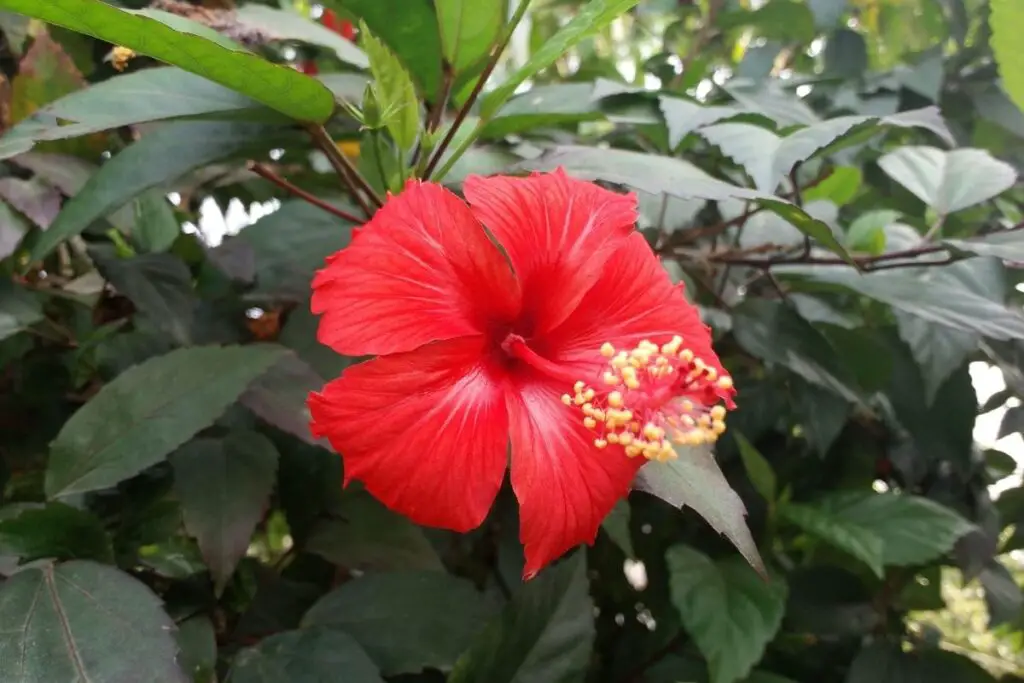
Hibiscus is a popular plant with trumpet-shaped blossoms in colors like white, pink, red, yellow, and orange.
Its beautiful flowers will attract butterflies and hummingbirds to your garden. It can withstand the heat waves of Texas as it is rugged and low maintenance.
Light: Hibiscus is best when kept in full lighting. They grow well in full sun and partial shade, especially during intense sun. If there is a lack of blooms, move the plant to a sunny spot.
Watering: Hibiscus likes to be well-rinsed. Water it regularly during its growing season and reduce it as winter approaches. Watering is crucial for the plant’s growth, but over-watering can cause severe issues. Ensure proper drainage to avoid sogginess.
Fertilizer: Hibiscus will comprehend monthly feedings with high potassium and nitrogen food. You can use fish emulsion and seaweed extract. The best timing is to start before the beginning of the bloom season and then monthly until the end of the flowering.
General care: Hibiscus flourishes in temperatures ranging from 60°F to 90°F. It can withstand temperatures as low as 20°F but would appreciate some protection at this time. High humidity keeps them going, and pruning in winter is also beneficial for their growth.
Daisies
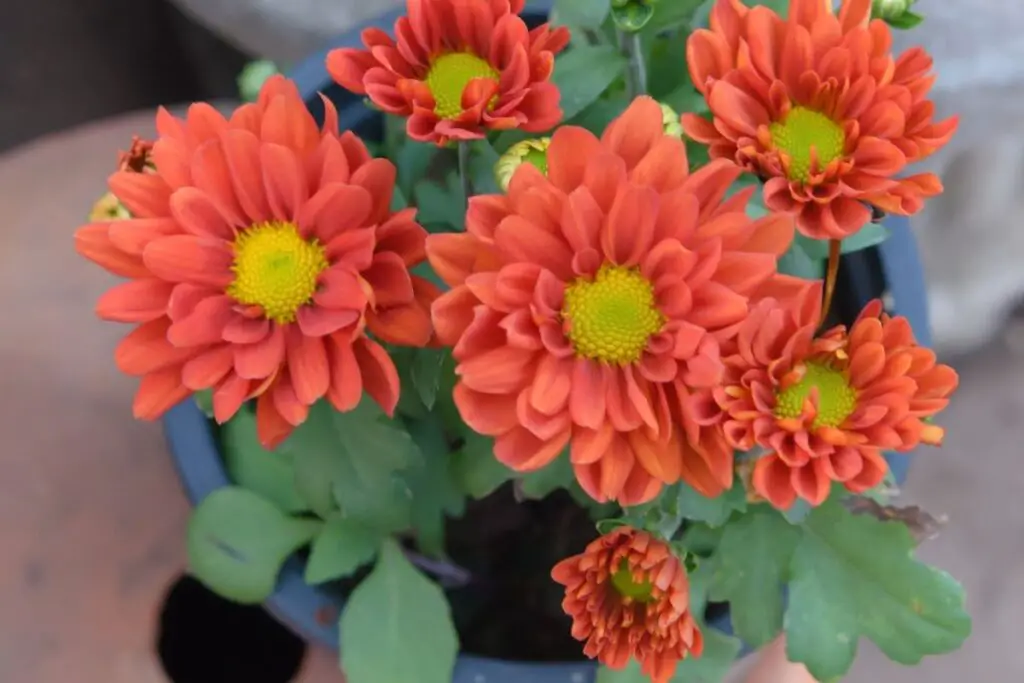
Daisies are the perfect choice to grow in Texas as it thrives in high temperatures. They feature cheery blooms in multiple colors of petals with a yellow center.
It’s ideal for pollinator gardens as it attracts bees and butterflies and is also perfect for rock gardens or any other garden you like. It can run wild in your garden due to its invasively spreading habit.
Light: Daisies flourish in a sunny location and can grow in partial shade too. However, in the intense midday heat, as r a shape over them to protect them
Watering: Water daisies in regular intervals as they like to stay hydrated. Mulching around the plant will help in retaining the soil moisture. Check the soil before watering if you’re growing daisies in pots to avoid saturation.
Fertilizer: Feed daisies in the spring with a balanced liquid or slow-release fertilizer. If you choose liquid fertilizer, feed the plant monthly during its growing period. Being heavy feeders, they will benefit from monthly feeding.
General care: Daisies can condone high temperatures but prefer cool temperatures. In excessive heat, the plant can even die off. They can handle light frost but should be protected in cold weather. I like to keep them in high humidity or keep misting around them.
Columbine
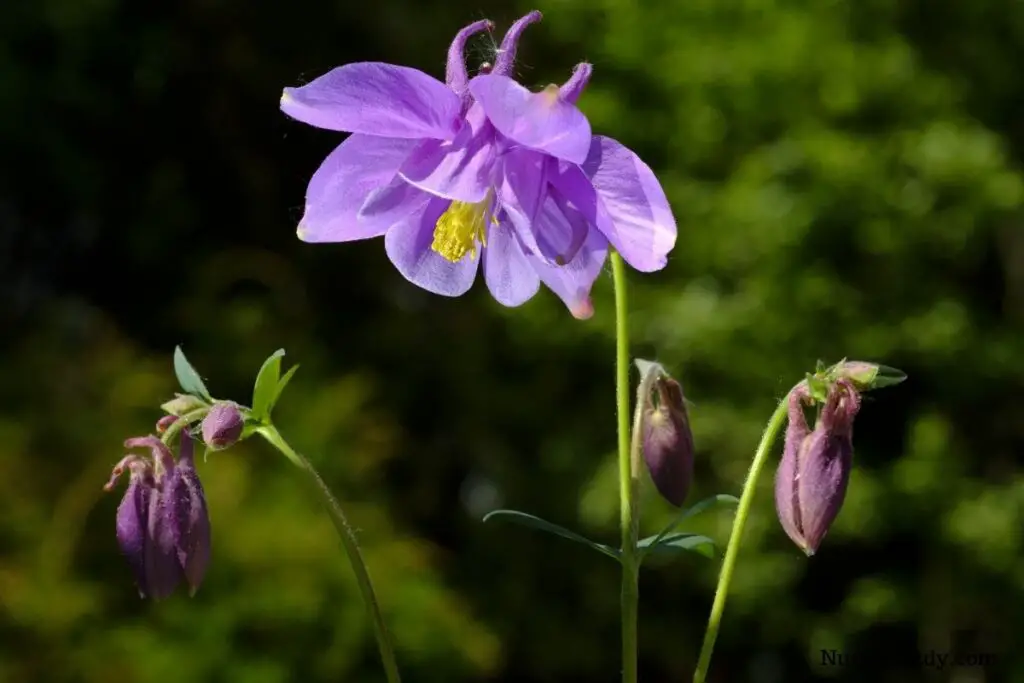
Columbine generates attractive foliage and blooms in multiple colors. It will attract butterflies and hummingbirds to your garden.
It will grow in Texas weather but will need adequate watering. It can self-sow if you allow its flowers to seed.
Light: Columbine prefers partial shade and may wane in intense summer. If growing it in full sun, ensure it is well watered. They can tolerate full sun in cool temperatures.
Watering: Watering Columbine satisfactorily is crucial to keep it going. Water it deeply when its soil dries from the top. Established Columbine is tolerant to drought. Mulch around the base of the plant to retain moisture in the summer.
Fertilizer: Columbine will benefit from monthly feeding with liquid fertilizer. It appreciates high phosphorus fertilizer for healthy roots. Avoid using high nitrogen fertilizer as it can hinder its flower production.
General care: Columbine will perform best in cool temperatures. It will struggle in high temperatures and prefer some extra care during such conditions. Deadheading will encourage continuous blooming.
Mealycup sage
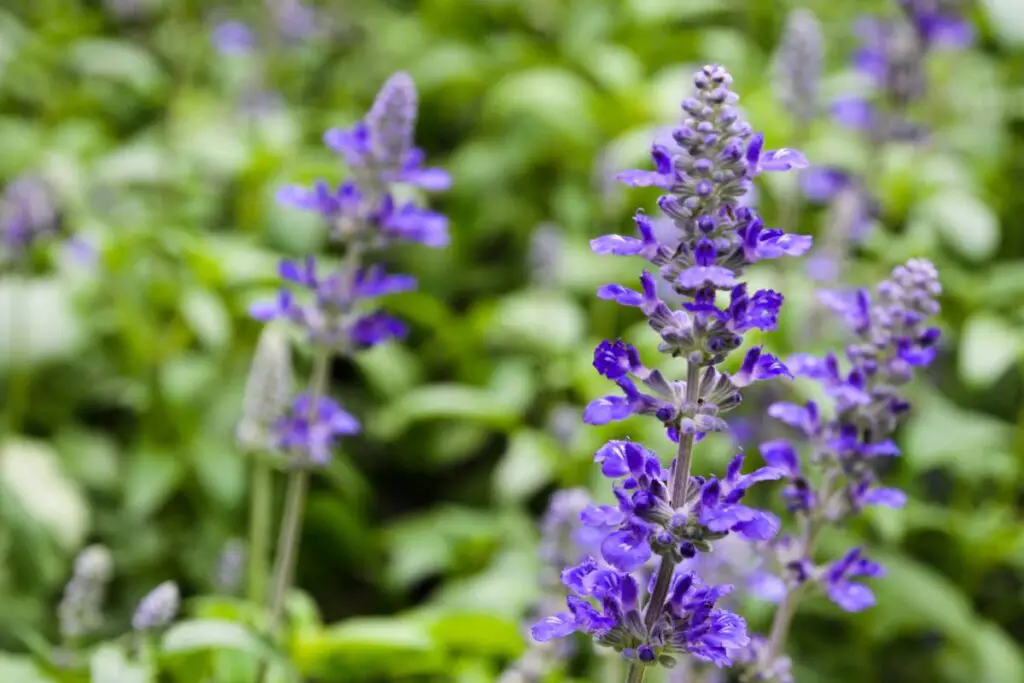
Mealycup sage is famous for its spiky blue blooms and potential to bloom for five straight years in ideal conditions.
Its leaves are lengthened and shiny with a familiar fragrance. It is a tough plant and will survive neglect too. It is fast growing and flowers within four months of planting.
Light: Mealy Cups evolve well in well-lit areas. It enjoys full sun in cool weather and prefers shade during intense heat. Avoid keeping it in a shaded location for an extended period, or it will begin to decline.
Watering: Mealy cups, while growing, needs regular watering to establish strong roots. Once installed, they become drought-tolerant. In hot climates, aim to water them daily as the roots are not strong enough to tolerate drought.
Fertilizer: Mealy cups growing in rich soil develop quickly without any feeding. If there are lesser blooms and slow growth, you can mix organic compost or balanced fertilizer mid-summer in the ground.
General care: Mealycup sage appreciates warm temperatures and may struggle in temperatures above 100°F. Mealycup sage will perform well in both humid and arid conditions. Keep them in good airflow if there is high humidity.
Looking for gardening supplies? We have tested 100's of products before recommending them to you guys. Check out our best pick below:
| Image | Gardening Supplies | Best Price? |
|---|---|---|
 Top
Top Top
Top | Raised Garden Bed Kit | Check On Amazon |
 | XLUX Soil Moisture Meter, Plant Water Monitor, Soil Hygrometer Sensor for Gardening, Farming, Indoor and Outdoor Plants, No Batteries Required | No Results |
 Top
Top Top
Top | 82 Pcs Garden Tools Set and Extra Succulent Tools Set | Check On Amazon |
 | Joeys Garden Expandable Garden Hose with 8 Function Hose Nozzle, Lightweight Anti-Kink Flexible Garden Hoses, Extra Strength Fabric with Double Latex Core, (50 FT, Black) | No Results |
 Top
Top Top
Top | Dual Chamber Compost Tumbler | Check On Amazon |
 Top
Top Top
Top | Sunnyglade Plant Stakes | Check On Amazon |
 Top
Top Top
Top | Organic Cold Pressed Neem Seed Oil | Check On Amazon |
 Top
Top Top
Top | Mighty Mint Gallon :-Insect and Pest Control Peppermint Oil | Check On Amazon |
 Top
Top Top
Top | Scotts DiseaseEx Lawn Fungicide | Check On Amazon |
 Top
Top Top
Top | Jacks Classic 20-20-20 All Purpose Fertilizer | Check On Amazon |
 Top
Top Top
Top | 30,000 Seeds Pollinator Attracting Wildflower Mixture | Check On Amazon |
 Top
Top Top
Top | Survival Vegetable Seeds Garden Kit-Over 16,000 Seeds | Check On Amazon |
Leadwort
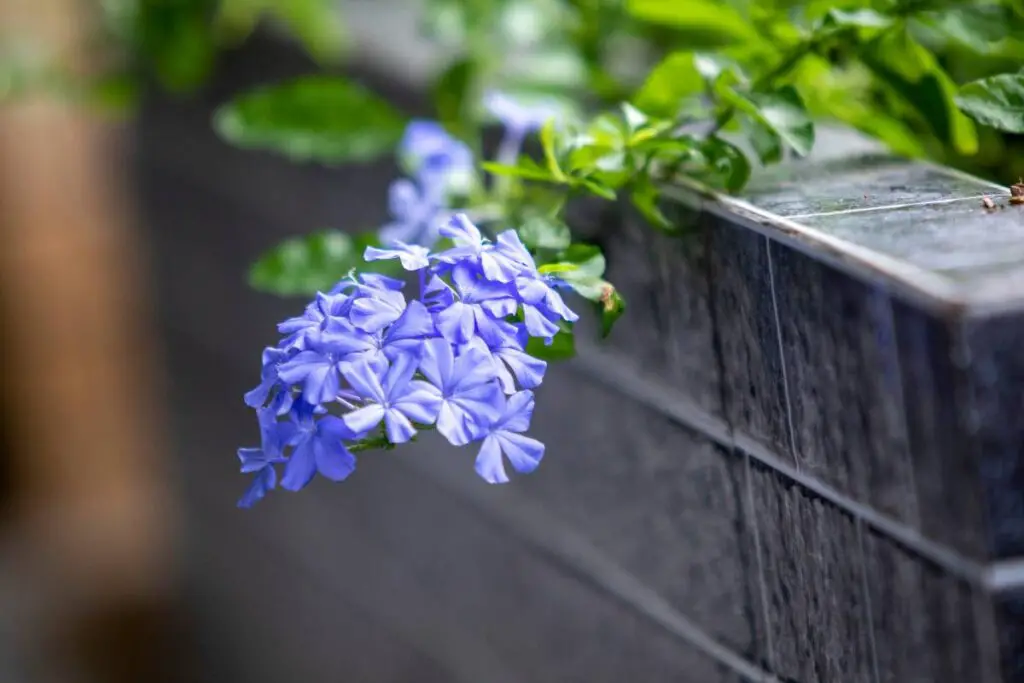
Leadwort produces star-shaped blue flowers with small oval-shaped foliage. It blossoms in mid-summer on stalks and can endure until the first frost.
Due to its complex and flexible nature, it is considered the best choice for growing in Texas. It looks beautiful as ground cover and will stay intact in ignorance too.
Light: Leadwort will grow in most light conditions, from full sun to partial shade. Though some shade during hot afternoon summers is beneficial.
Watering: Leadwort will grow well with little watering. Simply watering once a week is enough. Water the plant before it dries out completely and avoid sogginess, as it can result in root rot.
Fertilizer: Feed leadwort with a slow-release food in the early spring to promote new growth. Feed again in the summer to help the plant spread. Avoid providing too much or more than as directed, as it can weaken the plant.
General care: Leadwort prefers cool temperatures but suffers from frost. It might wilt in too high but will bounce back in moderate temperatures. During winter, mulching acts as a guarding layer for the plant. They can survive all humidity levels.
Garden Phlox
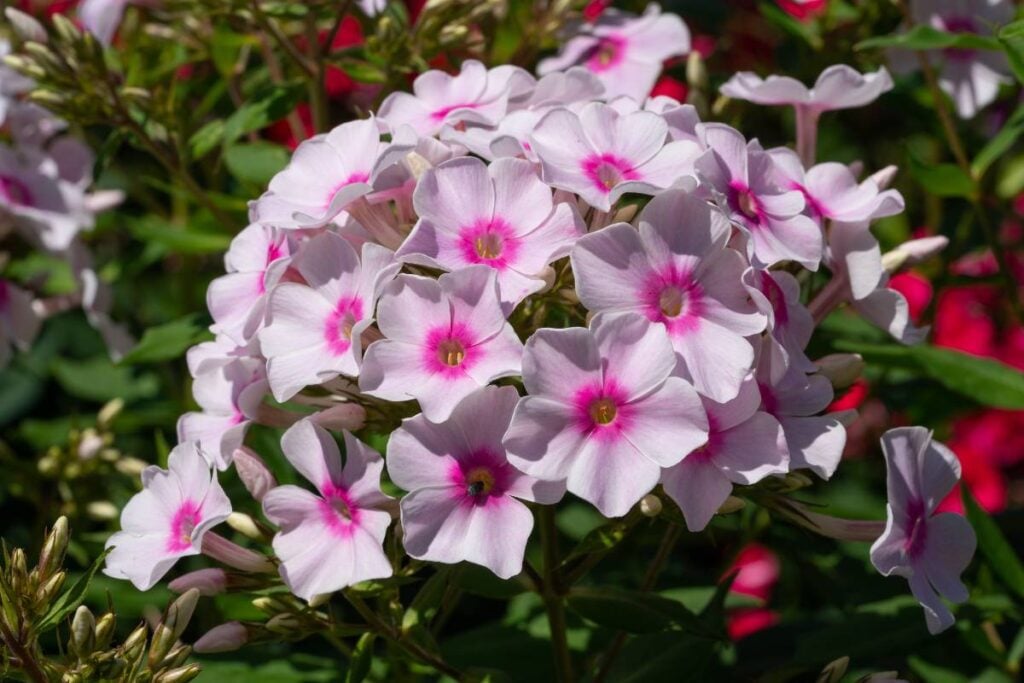
Garden phlox asks for minimal care and, in return, adds so much value with its long-lasting flowers.
It has sturdy stems, due to which it serves as cut flowers. It attracts beautiful butterflies and hummingbirds. It will come year after year if its minimum care requirements are met.
Light: Garden phlox can grow in full sun to partial shade. However, the hot sun in the south is unbearable for the plant. It is advised to add mulch to its roots to keep it cool.
Watering: Keep the garden phlox well-watered but avoid over-watering. While watering, water at the growing level and not from the top of the plant to prevent powdery mildew.
Fertilizer: Feed garden phlox with compost once in the spring. Too much fertilizing can cause the plant to suffer and affect its growth.
General care: Garden phlox prefers cool, arid temperatures. Avoid keeping it in too much humidity and maintain low to average moisture. Deadhead vanished flowers to prolong the flowering period.
New England Aster
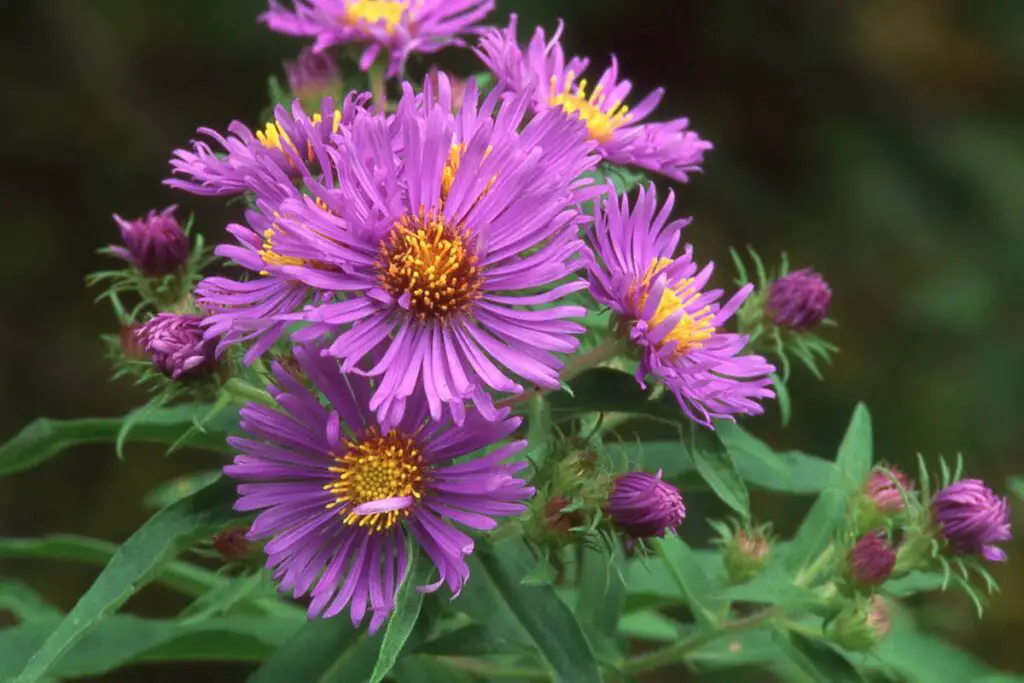
New England Aster has erect stems and daisy-like flowers. The flowers have yellow-orange centers and attract pollinators such as hummingbirds, butterflies, and bees.
It is easy to grow Aster from seeds as they will only begin to flower in their first year. Growing up in Texas is a great choice, as it is hard enough to survive the heat.
Light: New England asters develop and bloom best in direct sun. Choose a site with at least 6 hours of sun daily for the plant.
Watering: Water New England Aster when the soil is halfway dry. Keeping its soil evenly moist will keep it healthy and happy. During dry periods, consider giving the plant a drink at regular intervals.
Fertilizer: Feed New England Aster when new growth begins, i.e., in the spring. Feed it with liquid fertilizer or granular fertilizer formulated for flowers. Use high in phosphorus fertilizer and follow the instructions on the label for the amount to be applied.
General care: New England Aster prefers moderate temperatures and may decline in very high temperatures. However, it will bounce back once the temperature cools down. Ensure proper air circulation around the plant, especially in a humid environment. You can stake long stalks when they become very tall.
Pentas
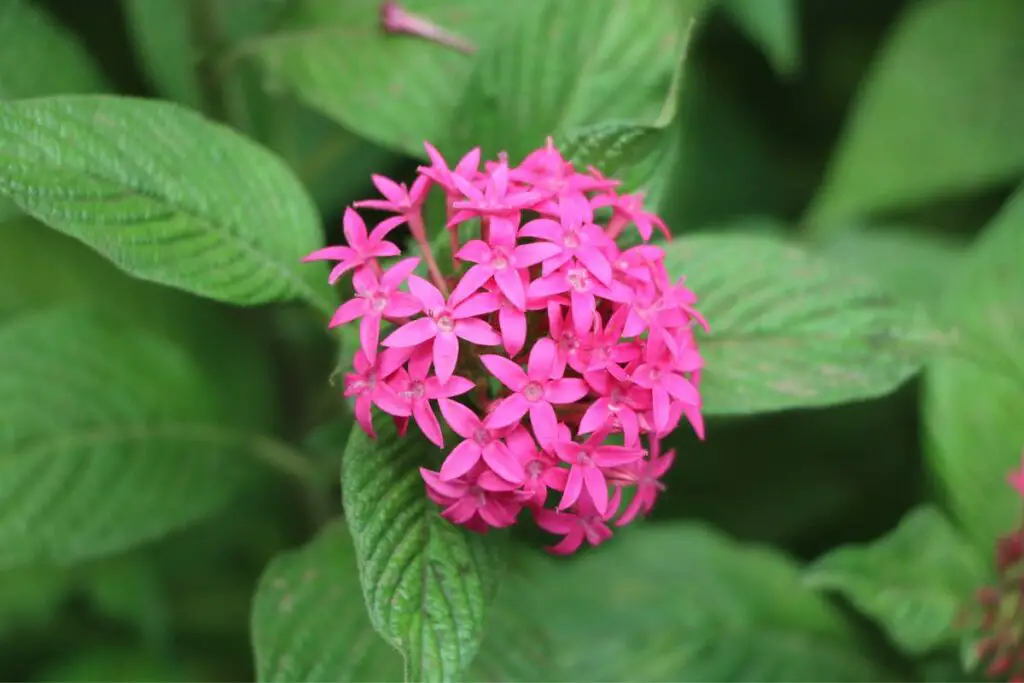
Pentas are popular plants known for their nectar-rich flowers in clusters in multiple colors. Their beautiful flowers invite butterflies, bees, and hummingbirds into your garden.
Because of their vitality, you can opt for them for your garden in Texas, i.e., in severe heat. Plant them as growing cover or in containers, and they will amp up your space.
Light: Plant pentas where they can get at least 6 hours of sun. They will grow in less light but have fewer blooms and become lanky.
Watering: Pentas appreciate regular drinks to have evenly moist soil. They can also survive in dry spells, but the long span of drought can result in spider mite infestations. Water from the soil to avoid leaf-related issues.
Fertilizer: Feed Pentas a balanced flower food monthly when they are actively growing. A fertilizer high in phosphorus encourages flowering, and high in nitrogen helps in healthy leaves.
General care: Pentas prefers hot and humid environments. However, they bloom best in warm weather. Trim them when the flowering goes down. Deadheading consistently prolonged the blooming season.
Sage
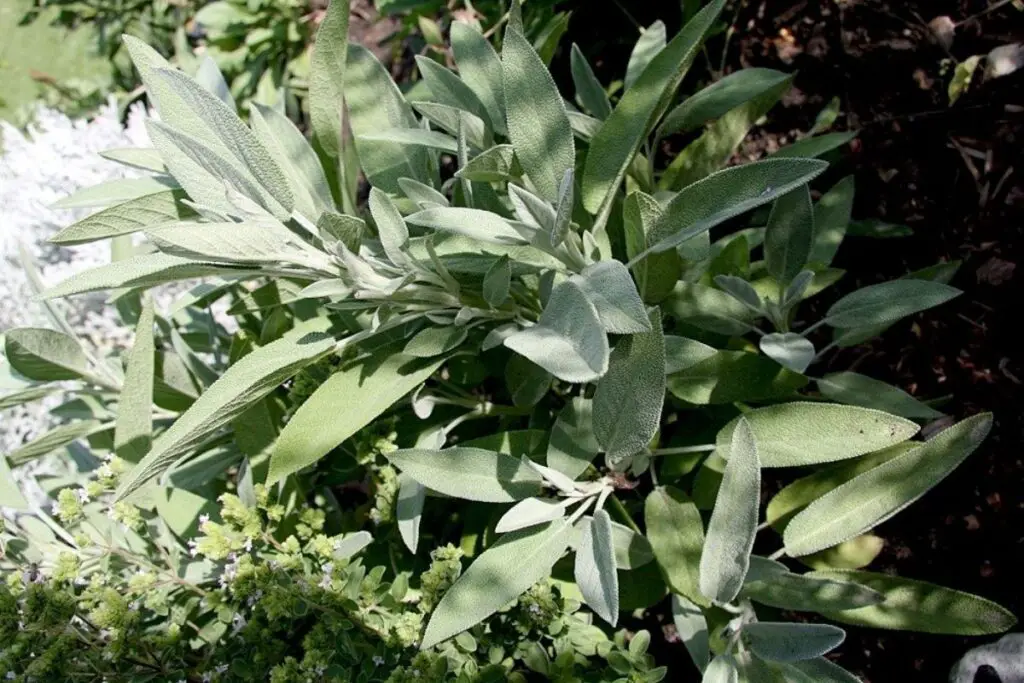
Sage features gray-green aromatic foliage that is also edible. It has blue-purple blooms on spikes that come in summer. This moderately growing plant can easily survive in the high heat of Texas.
Light: Sage will bloom best and have best-flavored leaves grown in full sun. It is essential to provide at least 6 hours of direct sunshine daily. Consider an afternoon shade if the weather is too hot in your region.
Watering: Sage appreciates evenly moist soil, though it can survive short periods of drought. Young sage plants need more frequent watering, and established plants are drought-tolerant.
Fertilizer: Feed sage with organic food formulated for edible plants. Feed it during the spring, or add compost to boost its nutrient content. Keep feeding on the lower side; otherwise, the flavor gets affected.
General care: Sage grows best in temperature levels between 60°F to 70°F. It can sustain some frost, but protecting it from such conditions is best. Maintain average humidity level around the plant.
Lantana
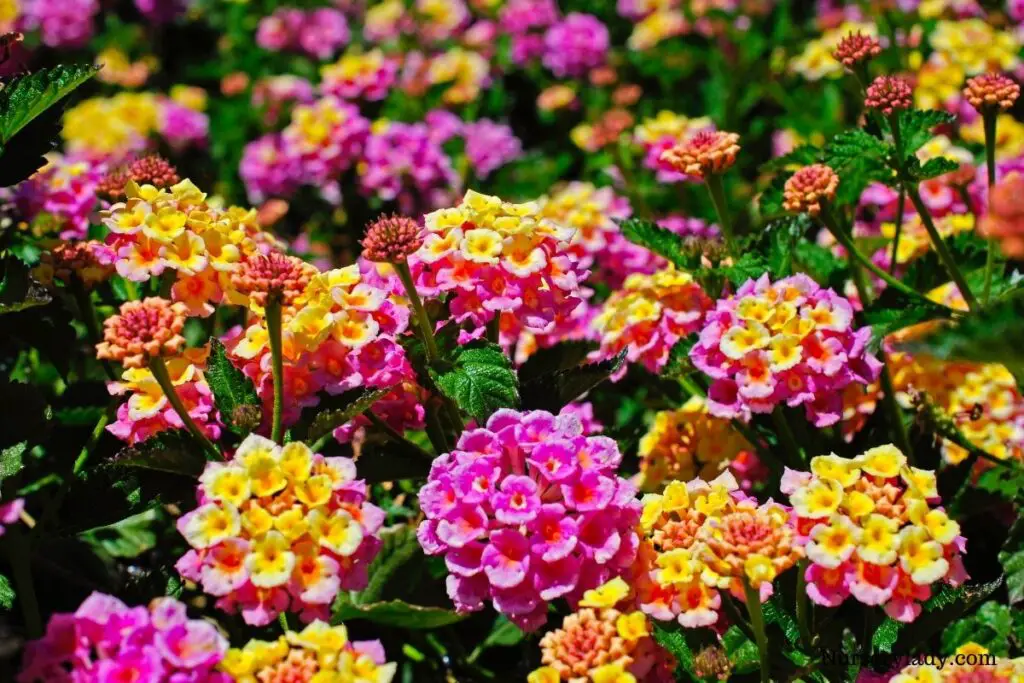
With its elegant-looking flowers in various colors, Lantana is the ideal choice for container gardening or as ground cover.
Mixing different shades of Lantana exhibits a bicolor effect. Its luscious nectar-rich flowers attract bees, hummingbirds, butterflies, and an unusual species spicebush swallowtail.
Light: Place the Lantana in a sunny location where it can receive maximum hours of direct sunlight. The plant will have fewer blooms and leggy growth if kept in low light.
Watering: Lantana performs best in moderate soil moisture. Let the halfway soil dry between watering to avoid saturation. If your plant appears unhealthy, water more frequently.
Fertilizer: Lantana growing in the ground does not need much feeding; feeding once in early spring is good enough. Lantana growing in containers needs monthly feeding with an equal liquid fertilizer. Avoid overfeeding, as it can inhibit the abundance of blooms.
General care: Lantana performs best at 55°F and above. It can withstand frost but declines if the temperature goes below 28°F. The plant may even die if the temperature remains low for too long. It prefers a humid environment. Also, prune it regularly if you wish for abundant flowering.
Melon cactus

Melon cactus inherently develops in Texas, which makes it used to the same climate conditions. It produces aesthetic flowers in shades of pink and red.
Due to its shape, the plant is also named Turk’s cap cactus. Plant melon cactus in spring for ornamental cephalium. The flowers also draw hummingbirds and butterflies in your garden.
Light: Melon cactus to produce those aesthetic flowers that demand full sun on most days. Please keep them in a location where they can receive at least 6 hours of sunlight daily. Choose the brightest spot if you are growing them indoors.
Watering: Established melon cacti are pretty drought-tolerant. Though melon cactus are at their best when watered at regular intervals. Ensuring their soil is neither wet all the time nor completely dry is essential for their healthy growth. Stick your finger in the soil and water if the soil feels dry.
Fertilizer: With regular fertilization, melon cactus will have the best growth and blooms. Feeding them with cactus or succulent food when they are actively growing is best. Avoid feeding them during fall and winter.
General care: Melon cactus, naturally grown in Texas, thrives in temperatures above 70°F. They will suffer as the temperature drops below 60°F. They may die of cold and frost.
Any humidity level is acceptable to them as long as other requirements are met. Pruning is not essential for them, though trimming dying parts is crucial to saving the entire plant.
Petunias
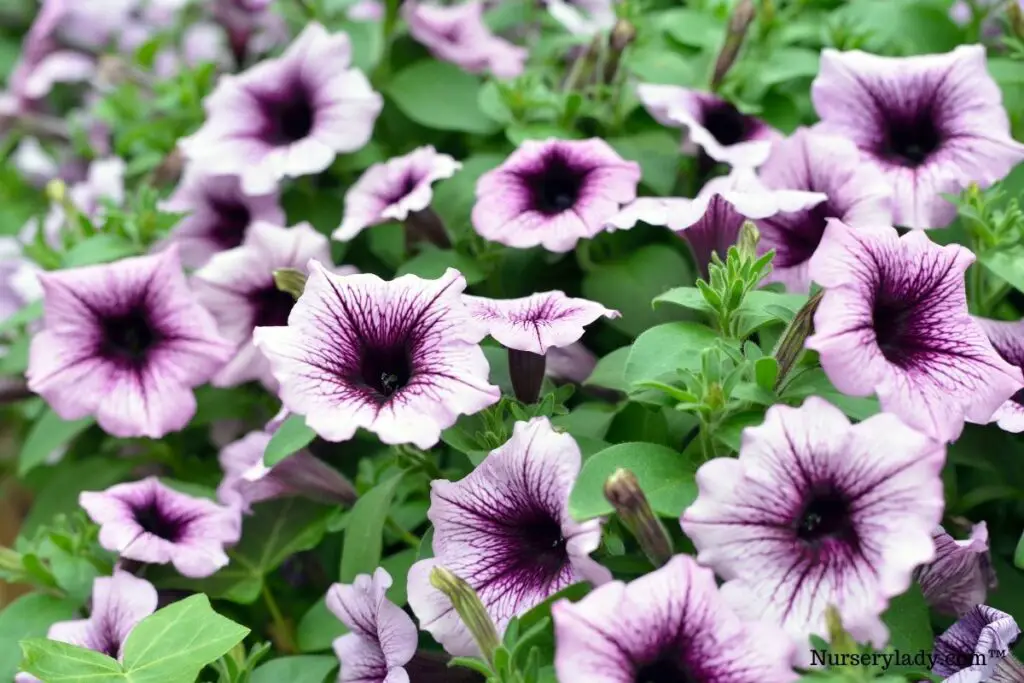
Petunias are cultivated plants with wide trumpet-shaped blooms, looking glorious as flower beds. The flowers come in every color except for blue.
With hairy branches, they have a variety of flowers that can be double or single with striped, solid, mounded colors and ruffled or smooth petals.
These fast-growing plants will mature by late spring and should not be planted in frost. Being a hot weather lover, these plants are the perfect choice for growing in Texas.
Light: Petunias will be blooming bright in direct sunlight. They enjoy sunlight but will appreciate shade when the sun is too intense in the summer afternoon. It is also helpful in preventing sunburn on leaves and flowers.
Watering: Water petunias when the soil feels dry to the touch. Leaving them dry for long periods can affect their growth and blooms. This doesn’t mean you can water them and leave them to die if drowning. Balance is vital for maintaining their health. Soak the plant with water if there is no rainfall and let them dry halfway between waterings.
Fertilizer: Petunias’ feeding is an integral part of their growth and development. Feed them while planting for a robust root system. Keep feeding the plant from July till they decline in the fall. Liquid fertilizer is better as it prevents overfeeding and promotes proper fertilizer distribution. You can also add organic compost while planting.
General care: Petunias thrive in temperatures ranging from 60°F to 75°F. They are not cold and hardy but can withstand temperatures up to 40°F. Freezing temperatures and frost can damage or kill the petunias.
Maintain low to moderate humidity around them. Pruning stems to promote branching, and bushier plants are good. Deadheading spent flowers and leggy growth.
Zinnias
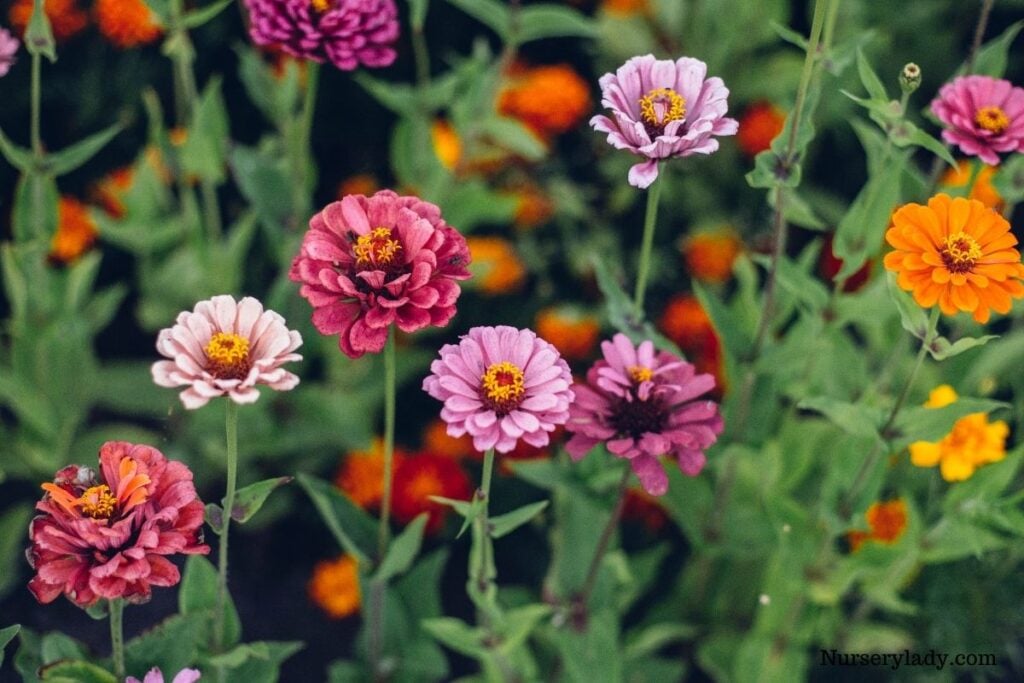
Zinnias are one of the best plants to grow in the hot climate of Texas. They will grow and bloom even in some ignorance.
Multiple colors are added every year to this fast-growing plant. Their hardiness and easygoing quality make them a favorite among gardeners.
Light: Keep zinnias in the brightest location to ensure total sun exposure. If they grow in low light, the plant’s growth will slow down and lead to issues like powdery mildew. Use an artificial light source if there is insufficient light in your house.
Watering: Zinnias will grow in some neglect. They can grow with little watering and are quite drought-tolerant. They will never die of dehydration.
Fertilizer: Feed zinnias occasionally with balanced liquid fertilizer. Apply the fertilizer by following the instructions given on the label to avoid overdose. They can even grow without any feeding.
General care: Zinnias being robust to hot climates, will keep flourishing in the most desirable of temperatures. Picking spent flowers or decorations promotes more flowering.
Cornflower
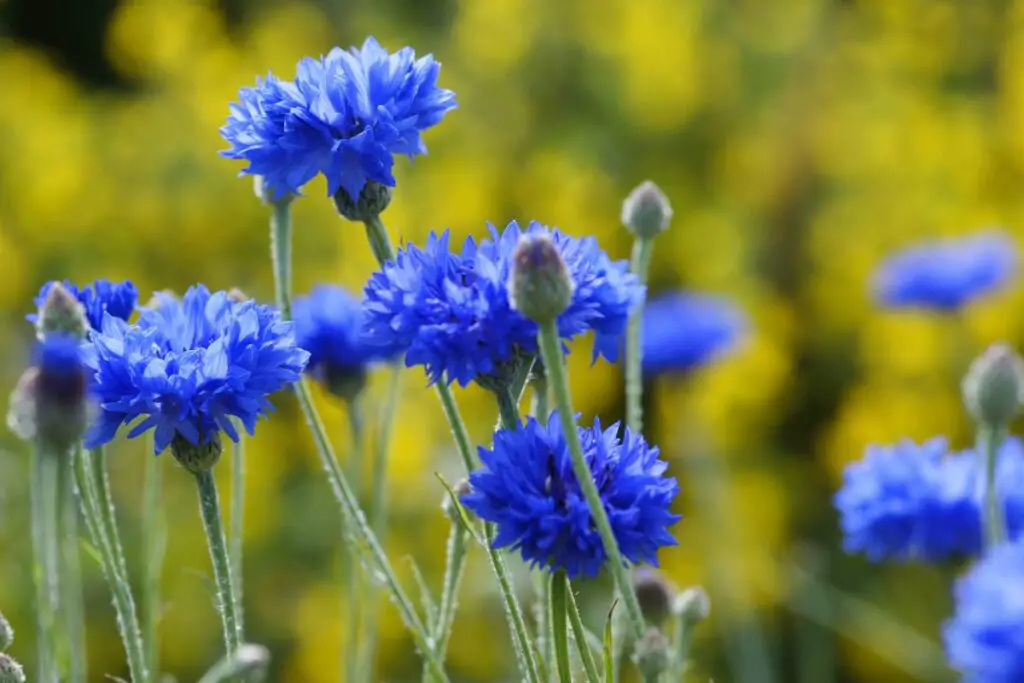
Cornflowers are beloved amongst gardeners due to their easygoing attitude. It features large blooms on the top of slim stems. The flowers in multiple colors bloom from spring till mid-summer.
Being a hardy plant, it can survive in most climatic conditions. It is a good choice for beginners and those residing in Texas. It can grow up to 48 inches in height and 12 inches wide.
Light: Cornflowers will have decent flowers when getting direct sun on most days. You can put it under a shade during a hot summer afternoon for relief. Leggy and floppy growth indicates a lack of sunlight and should be acted upon immediately.
Watering: Water cornflowers often during hot summer months to avoid drought conditions. Give the plant a drink as the soil feels dry up to a few inches from the top.
Fertilizer: If the soil mix is poor, feed cornflowers with diluted balanced fertilizer, manure, or compost tea. Feed it while young and keep feeding it throughout summer. It is best to add compost into the soil while planting for healthy and fulfilling growth. If the soil mix is rich, there is no need to feed the plant.
General care: Cornflower is flexible to both light freeze and high temperatures. The ideal temperature is between 60°F to 80°F. It flourishes in low to moderate humidity. In a humid environment, ensure good airflow around the plant to avoid fungal disease. Deadheading spent flowers to prolong the flowering season
Marigold
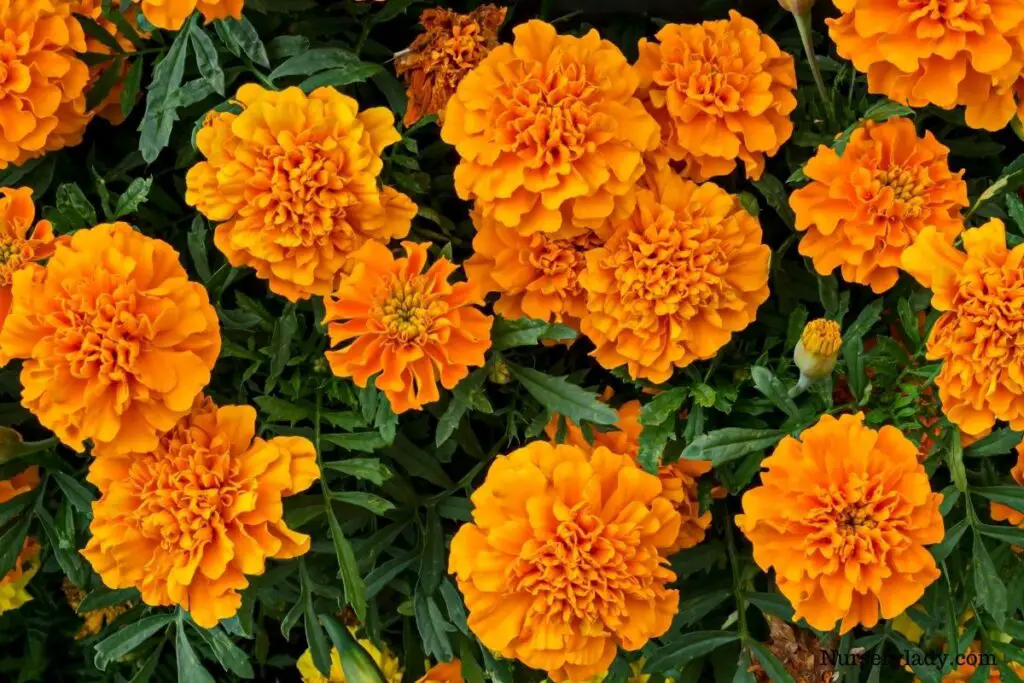
Marigolds are popular plants with an easygoing attitude. They will grow well in warm weather featuring cherry orange and yellow flowers. They will flower in a few months of planting and bloom from summer to fall.
Being annuals, they will complete their life cycle in one growing period, but planting seeds in the spring will keep them coming. They are primarily free ants and will also save neighborhood plants from pests as a bonus.
Light: Marigolds are sun-loving plants with the best flowering in full sun. Please keep them in the sunniest part of your home for lighting needs. Low light for an extended period can reduce their flowering and lead to leggy growth.
Watering: Water young marigolds regularly to keep the soil evenly moist. Leaving the plant dry for a few days can affect its growth. When the weather is hot, water them daily for a vigorous plant. After getting established, they became drought-tolerant.
Fertilizer: Feed marigolds only if they grow in an inferior soil medium. They will grow without feeding if the soil is rich. If you want non-stop blooming, deadheading is enough.
General care: Marigolds thrive in hot weather. They might have fewer blooms in the hottest summer but will return with abundant flowers as the temperature goes down. They can withstand all humidity levels but need extra care in high humidity. Deadhead spent flowers regularly to promote new blooms in the fall.
Daffodils
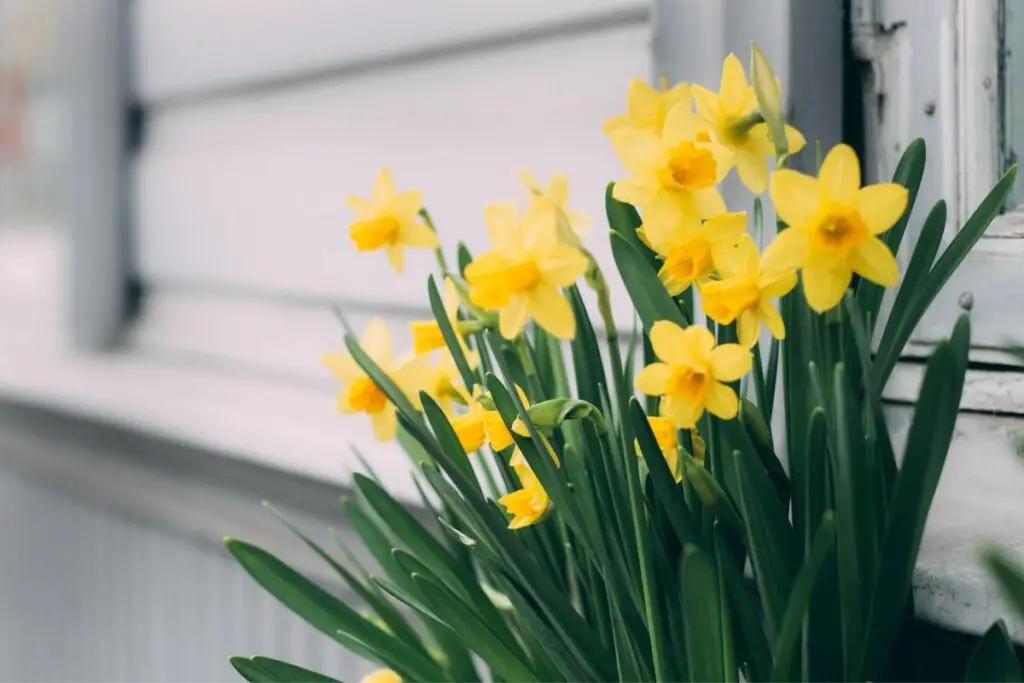
Daffodils are the hardiest plant on this list which can withstand pests, extreme heat, fungal diseases, etc. Their trumpet-shaped blooms will brighten up your garden in early spring till frost.
Their sturdiness makes them a perfect candidate for the hot environment of Texas. Also, beware daffodils are toxic to humans and animals both.
Light: Daffodils are sturdy plants that can survive almost all conditions. They flourish best in full sun. It is crucial that they will work well with shaded locations by midsummer through proper sunlight in their flowering season.
Watering: Daffodils like evenly moist soil, especially during the spring and fall. As the flowering fades, the plant’s water requirement decreases and it prefers dry soil during summer.
Fertilizer: Feed daffodils only if they are growing in poor soil. If there is less flowering than they should be, consider feeding them with bulb fertilizer. Feed as per the instructions on the label to avoid overdose.
General care: Daffodils prefer cold weather while they are dormant. Depending on the variety you are growing, their environmental needs change. They can grow well in both arid and humid conditions. Since they bloom once in a season, allow their leaves to dry so that they absorb light essential for the bulb for future blooms.
Coneflower
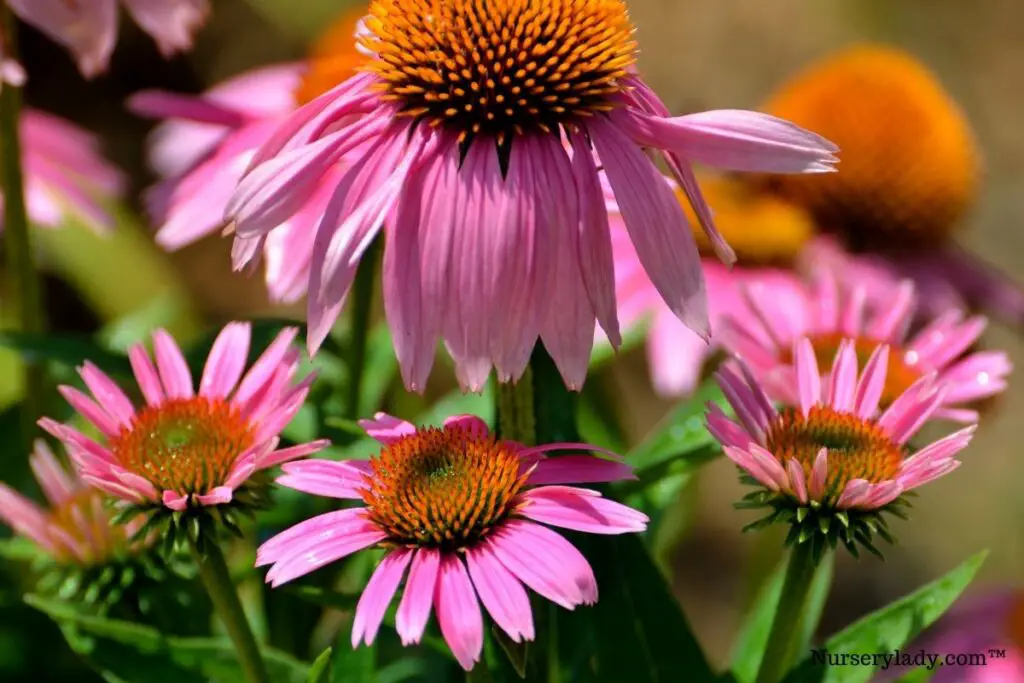
Coneflowers are low-maintenance plants with perks like hardiness, drought tolerance, long blooming, and endless colorful blooms.
Their prominent bright colors are nectar-rich, drawing bees and butterflies into the garden.
Light: Plant coneflower in a sunny location, so they receive 6-8 hours of full sun daily. They appreciate some shade during the hottest summer months. Too much shade may result in floppy and weak plants with fewer blooms.
Watering: Water coneflower consistently and allow the soil to dry halfway between waterings. They are drought tolerant, but watering as per need is suitable for their health. However, established plants may need water during long periods of drought.
Fertilizer: Coneflowers are light feeders, and too much feeding can result in leggy growth. Adding compost into their soil once in the spring is enough for healthy foliage and abundant blooming.
General care: Coneflower grows well in hot and dry weather. They can tolerate a variety of temperatures and humidity levels. However, too much humidity can affect their health and cause problems in the plant. You can prune them to prolong their flowering season.
